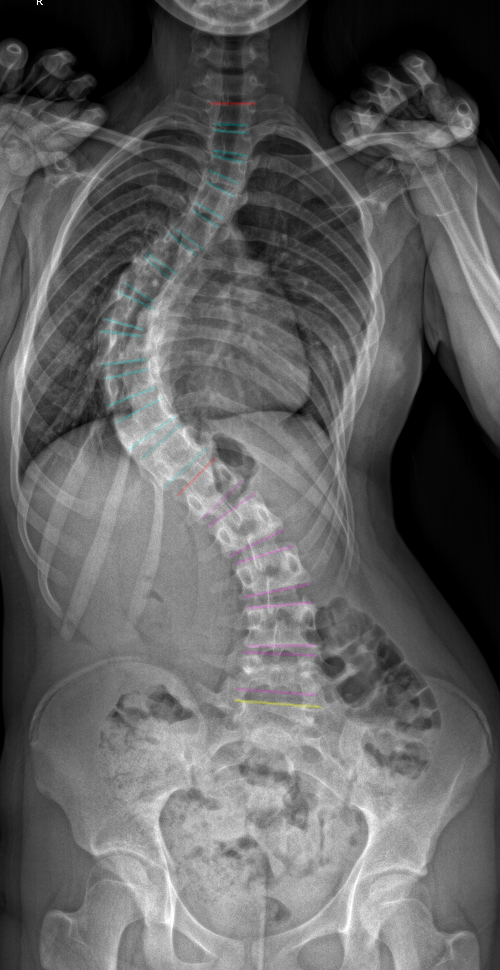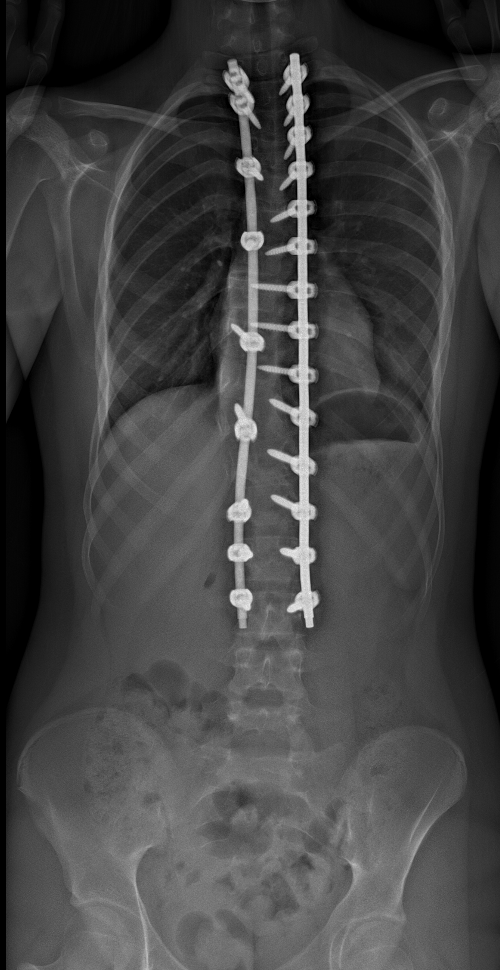Adolescent Idiopathic Scoliosis
Scoliosis surgery is a procedure to correct the curve in your spine. The most common type of surgery for scoliosis is called “spinal fusion.” This surgery aims to straighten your spine and stop the curve from getting worse as you grow.
Why is Surgery Needed? If your spine has a significant curve that might keep getting worse, surgery can help. Without surgery, a severe curve can cause problems, like making it hard to breathe, causing pain, or affecting how your body looks. Surgery helps prevent these issues and keeps you healthy.
What Happens During the Surgery?
Preparation
-
- You’ll be given medicine to help you sleep during the surgery, so you won’t feel anything, nor remember anything.
- Once asleep, you will have an IV line, and a urinary catheter placed so that the anaesthetist can monitor you safely throughout the surgery.
- The surgery usually takes a few hours.
Accessing the Spine
-
- A/Prof Buckland will make an incision (a cut) in your back to reach your spine.
- The muscles are carefully detached from the back of the spine to allow access to the bone of your spine (vertebrae).
Straightening the Spine
-
- The spine is made more flexible by releasing ligaments and bone to allow us to straighten the spine.
- Screws or hooks are placed in each vertebra using computer navigation technology to improve accuracy and safety.
- Metal rods are used to attach to the screws in order to straighten it out and hold it in the correct position.
- Spinal cord monitoring is used throughout the surgery to keep your nerves safe.
Fusing the Spine
-
- A/Prof Buckland will place small pieces of bone, obtained from the local bone or from a donor, between the vertebrae (the small bones that make up your spine).
- Over time, these bones will grow together, or “fuse,” creating a solid bone that holds your spine straight.

Pre Op X-Ray 2

Post Op X-Ray 2
Closing the Incision
-
- Once the spine is straightened and the rods are in place, A/Prof Buckland will close the muscle layer, and incision with sutures.
- A drain is sometimes placed to protect the wound, and it is removed 2-3 days after surgery.
What to Expect After Surgery
Recovery in the Hospital
-
- After surgery, you’ll wake up in a recovery room where doctors and nurses will monitor you to make sure everything went well.
- You’ll stay in the hospital for 3-4 days. During this time, you’ll have some pain, but the treating team will give you medicine to help you feel better.
- We will gradually remove the catheter and IV over the next 2-3 days.
- We will encourage you to walk with supervision and to have all meals out of bed in the chair.
At Home Recovery
-
- Once you go home, we encourage you to walk and stay out of bed, but to avoid certain activities while your spine heals such as lifting, bending and twisting.
- Most kids can go back to school in a few weeks, but it might take a few months before you can return to sports or other physical activities.
Questions and Support
It’s normal to feel nervous about surgery, but remember, the treating team are here to take care of you. After surgery, you might feel sore and tired, but as you heal, you’ll start feeling better and more energetic.
It’s important to ask if you have any questions or if something worries you. We’re here to make sure you understand everything and feel comfortable with what’s happening.
You can download A/Prof Buckland’s surgery information booklet, which contains most of the relevant information for your upcoming surgery, below.
Our Commitment to Research and Improving Patient Outcomes
As part of A/Prof Buckland’s standard of care, he asks patients to participate in the Australian Paediatric Spine Registry in addition to allowing contribution of your de-identified surgical and outcomes data to Harms Study Group and/or Paediatric Spine Study Group to enable surgeons to improve quality and safety of scoliosis surgery care for future patients. A/Prof Buckland will discuss these initiatives with you and your family and obtain your permission before doing so.
Summary
In summary, surgery for scoliosis is performed to prevent further progression of a severe curve, improve appearance and posture, alleviate pain, prevent long-term health complications, and restore spinal balance and function. Click here to learn more about A/Prof Buckland’s results of scoliosis correction surgery.

